Super Talent SSD: 16GB of Solid State Goodness
by Gary Key on May 7, 2007 4:00 AM EST- Posted in
- Storage
Hard Disk Performance: PCMark05
We are utilizing the HDD test suite within PCMark05 for further comparative hard disk scores as it provides a mixture of actual application results and specific read/write percentages utilized within these programs. It is also a readily available benchmark that others can use for comparative purposes. The program utilizes the RankDisk application within the Intel iPeak SPT suite of tools to record a trace of disk activity during usage of real world applications. These traces are then replayed to generate performance measurements based upon the actual disk operations within each application. The HDD test suite contains 53% read and 47% write operations with each trace section utilizing varied amounts of read or write operations. Additional information about the test suite can be found in PDF format here PCMark05 whitepaper.
The PCMark05 test results are based upon the following trace runs:
Windows XP Startup: This test consists of 90% reading and 10% writes that tracks XP activities at start-up.
Application Loading: This test consists of 83% reading and 17% writes that tracks the opening and closing of the following programs.
File Write: This test consists of 100% write activities by writing 680MB of files onto the hard disk.
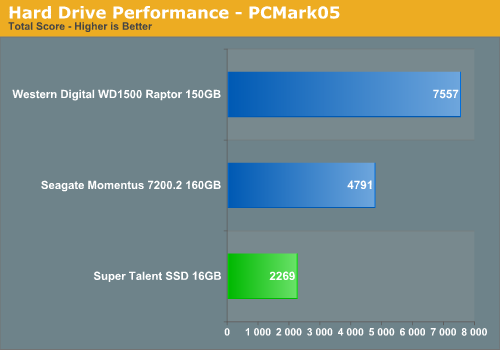
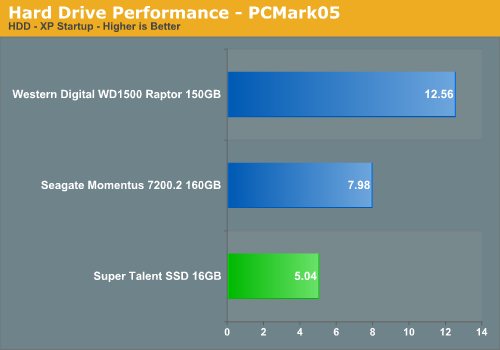
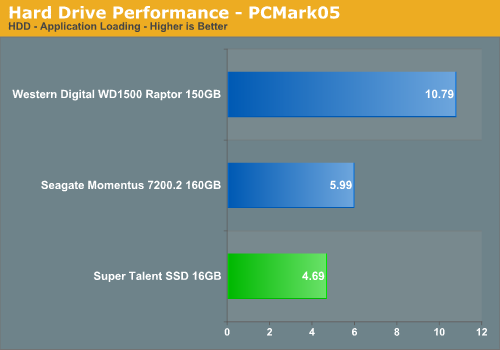
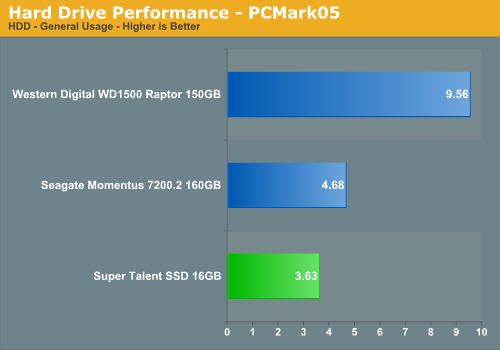

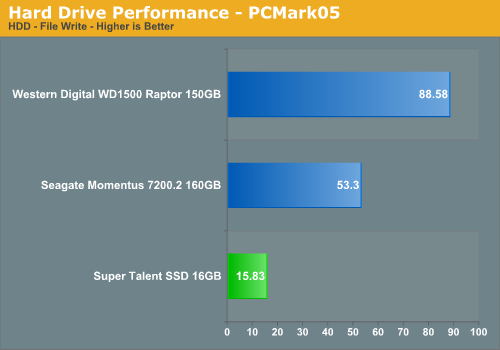
Our PCMark05 results show the Super Talent drive performing as expected considering the read and write speeds are limited to an average of 25 MB/sec. Solid State Drives feature extremely low access times that are usually in the <1ms range and with no moving parts the first three PCMark05 test that feature read speeds over write speeds show the drive being competitive to some degree even with the industrial usage design.
We fully expected the File Write tests to show major differences based on the low write speeds of the disk and it does when compared to our other test drives. However, these differences are minor when considering the drive will be used in applications where write speeds are not paramount to the performance of the drive. The results in PCMark05 will be reproducible in our limited test suite.
We are utilizing the HDD test suite within PCMark05 for further comparative hard disk scores as it provides a mixture of actual application results and specific read/write percentages utilized within these programs. It is also a readily available benchmark that others can use for comparative purposes. The program utilizes the RankDisk application within the Intel iPeak SPT suite of tools to record a trace of disk activity during usage of real world applications. These traces are then replayed to generate performance measurements based upon the actual disk operations within each application. The HDD test suite contains 53% read and 47% write operations with each trace section utilizing varied amounts of read or write operations. Additional information about the test suite can be found in PDF format here PCMark05 whitepaper.
The PCMark05 test results are based upon the following trace runs:
Windows XP Startup: This test consists of 90% reading and 10% writes that tracks XP activities at start-up.
Application Loading: This test consists of 83% reading and 17% writes that tracks the opening and closing of the following programs.
- Microsoft Word
- Adobe Acrobat Reader
- Windows Media Player
- 3Dmark 2001SE
- Leadtek WinFast DVD
- Mozilla Internet Browser
- Opening a Microsoft Word document, performing grammar check, saving and closing
- Compression and decompression using WinZip
- Encrypting and decrypting a file using PowerCrypt
- Scanning files for viruses using F-Secure Antivirus
- Playing an MP3 file with Winamp
- Playing a WAV file with Winamp
- Playing a DivX video using the DivX codec and Windows Media Player
- Playing a WMV video file using Windows Media Player
- Viewing pictures using Windows Picture Viewer
- Browsing the Internet using Microsoft Internet Explorer
- Loading, playing and exiting a game with Tom Clancy's Ghost Recon
File Write: This test consists of 100% write activities by writing 680MB of files onto the hard disk.






Our PCMark05 results show the Super Talent drive performing as expected considering the read and write speeds are limited to an average of 25 MB/sec. Solid State Drives feature extremely low access times that are usually in the <1ms range and with no moving parts the first three PCMark05 test that feature read speeds over write speeds show the drive being competitive to some degree even with the industrial usage design.
We fully expected the File Write tests to show major differences based on the low write speeds of the disk and it does when compared to our other test drives. However, these differences are minor when considering the drive will be used in applications where write speeds are not paramount to the performance of the drive. The results in PCMark05 will be reproducible in our limited test suite.










44 Comments
View All Comments
Samus - Monday, May 7, 2007 - link
Simply awesome, thanks for the review Gary. This is exciting technology for sure. Only took them 20 years to make it cost effective and reasonably good storage.redbone75 - Monday, May 7, 2007 - link
I would say SSD's have a few more years to go before they become cost effective, in the home consumer market, anyway. That market will be very small until the price/GB becomes more reasonable.Lonyo - Monday, May 7, 2007 - link
Is there any chance for comparison of some 1.8" drives in the future?Since 1.8" mechanical drives are somewhat slower than 2.5 or 3.5" mechanical drives, and 1.8" laptops are looking at things like low power consumption, it would be nice to see, assuming you can get hold of some 1.8" drives of both types.
Reflex - Monday, May 7, 2007 - link
These drives are great in an embedded or manufacturing environment. Typically they are not written to frequently so you will never hit the write limitations. As a desktop PC drive however that write limitation could be hit very quickly, within a year even. Furthermore, having worked with these drives extensively in embedded environments, I will point out that when the write limitation is hit, you can no longer read the device either. Since there is no real warning, you simply suddenly lose access to all data on that drive.Solid state storage is the future, but not in the form of today's flash. The write limitation is severe, and very problematic. There are competing technologies that hopefully will show up sooner rather than later.
falc0ne - Monday, May 7, 2007 - link
"The SSD16GB25/25M features a read seek time of less than 1ms, a maximum read/write speed of up to 28 MB/sec, a sustained transfer rate of 25 MB/sec, and an estimated write/erase cycle of approximately 100,000 cycles. This equates into a 1,000,000 hour MTBF rating and indicates a 10 year life expectancy based upon normal usage patterns. Super Talent has developed a set of proprietary wear leveling algorithms along with built in EDD/EDC functions to ensure excellent data integrity over the course of the drive's lifespan."This passage tells a completely different story..
mongo lloyd - Monday, May 7, 2007 - link
Dan at Dansdata.com has said the exact same things as Reflex here for quite a while, and I tend to believe him more than SuperTalent's PR department.Also, as Reflex points out, NAND flash has usually way more than 100,000 write/erase cycles. 1 million cycle is not too uncommon.
Regular CompactFlash memory (previously NOR flash, nowadays NAND flash) can take up to the same order of magnitude of write/erase cycles, and we all know memory cards for digital cameras have quite a finite life. And that's without putting a paging file on them.
PandaBear - Thursday, May 10, 2007 - link
It depends on what kind of Nand. MLC usually can barely hit 100k for good ones (i.e. Toshiba and SanDisk) while 5k for bad ones (i.e. some batch of Samsung that got rejected and they have to dump in the spot market).For a camera, you will have to wear out your camera's shutter before you can wear out the card, but for HD, you better have very good wear leveling and good nand before even attempting).
Gary Key - Monday, May 7, 2007 - link
The manufacturer's are taking a conservative path with the write/erase cycles per sector and it has been difficult to nail them down on it. The latest information I have from SanDisk as an example is that the non-recoverable error rate is 1 error per 10 to the 20th bits read on their current drives but they have not committed to active duty cycles or power-on hours in arriving at that calculation. The majority of the SSD suppliers are focused on MTBF ratings at this time. We will have further details in our consumer article as I expect Samsung to open up on the subject.PandaBear - Thursday, May 10, 2007 - link
Nand don't wear out by sitting around, they wear out by erase/program permanently or read disturb (recoverable just by a rewrite). So MTBF is meaningless. You have to do a lot of reading continuously in order to wear out by read. Actually there are algorithms that protect such cases already by refreshing it, so no harm is done.It is the write that really kills the sector, and Samsung did not mention its erase/program for a reason: they failed their own spec that many reputable clients rejected their order (i.e Sandisk rejected their order from Samsung MLC, and Apple uses excessive recovery algorithm to tolerate them on the audio playback, those Taiwanese cheap flash that you get for free with super slow performance or die after 2 weeks, well, you know what you will get when you open up the case).
For their SSD, they may use SLC instead for the performance and reliability reason. It costs 20% more in spot market, but manufacturing cost is much higher (almost 2x when you think about it), so it will cost more.
Reflex - Monday, May 7, 2007 - link
First off, 100,000 is a VERY VERY low write rating for flash, typical drives nowadays have 250k+ write cycles.Secondly, as pointed out by the article, the intended market is industrial and embedded, which as I stated originally, is an environment where the drives are rarely written to. Typically you have a bootable image in those environments, and it is write protected in some fashion, or requires a very small number of writes.
And finally, if you think 100k write cycles is a lot, watch the drive light on the front of your PC someday. Every flash is a minimum of one write or read operation. Calculate how many times that flashes in ten minutes of 'typical' use. Then extrapolate. You'll understand what I mean.